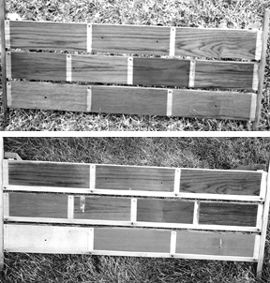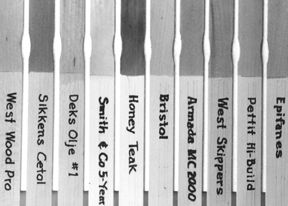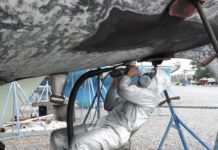Over the years, teak treatments and marine varnishes have been exhaustively tested by Practical Sailor. We can’t recall when a test frame of some kind wasn’t weathering away in the parking lot or in some editor’s backyard.

Among those out there now is one that brings together all the prior tests of oils, varnishes, pigmented stains and sealers. It pits the best of the 10 individual teak “treatments” in a single test intended to give boatowners a choice of how much effort they want to expend to keep their teak looking good. The products, as in the top-to-bottom order on the chart on pages 10-11, are three varnishes, Epifanes Woodfinish, Pettit Hi-Build and West Skipper; four synthetics, Armada MC 2000, Bristol Finish, Honey Teak, and Smith & Co. 5-Year Clear; one oil, Deks Olje; and two pigmented stains, Sikkens Cetol and West WoodPro.
As explained in the introductory piece—entitled “Teak Treatments All-Stars Grudge Match”—in the March, 2003 issue of PS, the intent is (1) to evaluate how the products go on, and how they look when first applied, and (2) subject all to the same exposure and see how they do over time.
The “rack” used to test the all-stars is a matched-board frame with 10 segments. It has 1″ horizontal protective strips to provide a comparison with the original teak. Finished indoors, the rack, was placed outdoors on January 15, 2003. After exposure to sun, wind, snow and rain (and a deliberate dash of saltwater) for six months (all of them pretty rotten in terms of weather this year) it was brought in on July 15, 2003.
The boards were wiped clean with a damp cotton cloth, then each segment was closely examined for film integrity, gloss, color, and for beading with a fine water spray.
The Deks Olje oil appears simply to have vanished, leaving the wood looking almost exactly like the vertical bleached strips. There was only a faint color difference.When PS called the Flood Co. to ask about the Deks Olje performance, Jackie Kirby, a technical advisor, said that the Deks Olje matte finish oil is considered to be good for one season, or about six months. “If a shinier, longer-lasting finish is desired,” she said, “the matte finish oil should be followed with multiple coats of the gloss version.”
Ms. Kirby asked that we talk further with Hugo Sandberg, Flood’s product manager. He confirmed Ms. Kirby’s comments.
Some breakdown, in the form of a dozen or so thin hair-like streaks, has occurred in the Smith & Co. 5-Year Clear synthetic. The film surface appears intact; the lighter-colored streaks are between the film and the teak. The film otherwise has retained much of its high gloss.
Another synthetic, Bristol Finish, displayed some pronounced fading at the end-grain edges (about 1/16″) of the panel, suggesting that something is getting under this high-gloss finish. It probably means that moisture is permeating end grain.
We should note that C Tech changed the formulation of Bristol Finish this March, after we had applied the old version to our test panels. According to Marshall Nix of C Tech, the new formulation was tested for almost three years before its release, delivers much higher performance, and is quite a bit easier to use, according to feedback from test customers.

One customer who isn’t happy with the new product is PS contributor Bill Seifert, who reported “cratering” in a 10-coat application of Bristol Finish that he oversaw on a 57-foot ketch. We asked Marshall Nix about this. He told us that he had tested the batch that Seifert returned to him, and found nothing wrong with it. Meanwhile, the revised product is being tried out by a number of high-end boatbuilders. So far, says Nix, no complaints.
The ways of coatings are often mysterious. We’ll get the new stuff on a panel ourselves, as soon as feasible.
Peculiar is the word to be used in the change in color of the Armada MC 2000. Although intact, the matte finish is dull, with a slight purple coloration.
The only synthetic that appears unchanged is the heavily-pigmented Honey Teak. It’s intact, but has a somewhat muddy appearance that obscures the grain and color of the teak.
The two pigmented stains—Sikkens Cetol and West WoodPro—appeared intact. The matte-finish coatings have faded somewhat, but it does not detract from their appearance.
The best by far, at this point, are the three varnishes—Epifanes, Pettit Hi-Build, and West Skipper. All are intact and very glossy. Epifanes, which had the best gloss when first applied, retains that distinction, although the other two are close behind.
What will happen after another six months of exposure? The rack, wiped clean, with numbers re-inked and protective strips replaced, is back out there for more melanogenesis.
Also With This Article
Click here to view “Teak Treatment All-Stars At Six Months.”
Contacts
• Armada Coatings, 800/336-9320, www.armadacoatings.com
• Bristol Finish (C Tech Marine), 321/752-7533, www.bristolfinish.com
• Deks Olje, 800/321-3444, www.floodco.com
• Epifanes, 800/269-0961, www.epifanes.com
• Honey Teak, 772/287-6077, www.signaturefinishes.com
• Pettit Paint, 800/221-4466, www.pettitpaint.com
• Sikkens Cetol, 011-31 10 5033 54, www.sikkensyachtpaints.com
• Smith & Co., 800/234-0330, www.fiveyearclear.com
• West Marine, 800/262-8464, www.westmarine.com





































